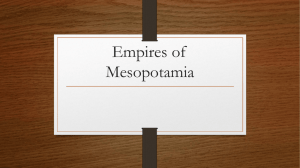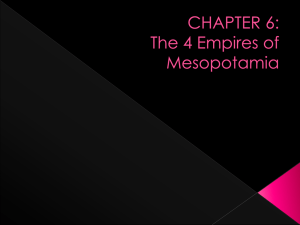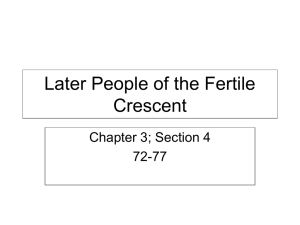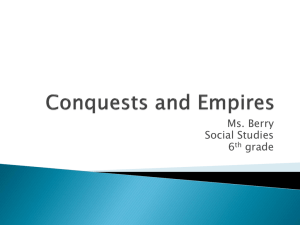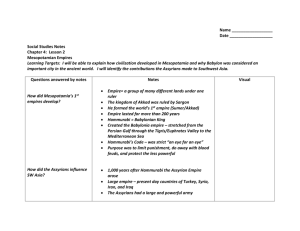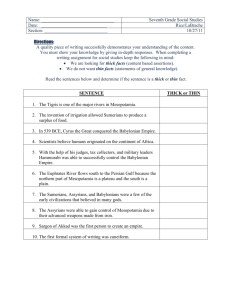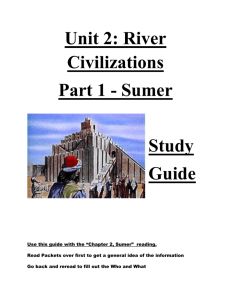Later People of the Fertile Crescent
advertisement
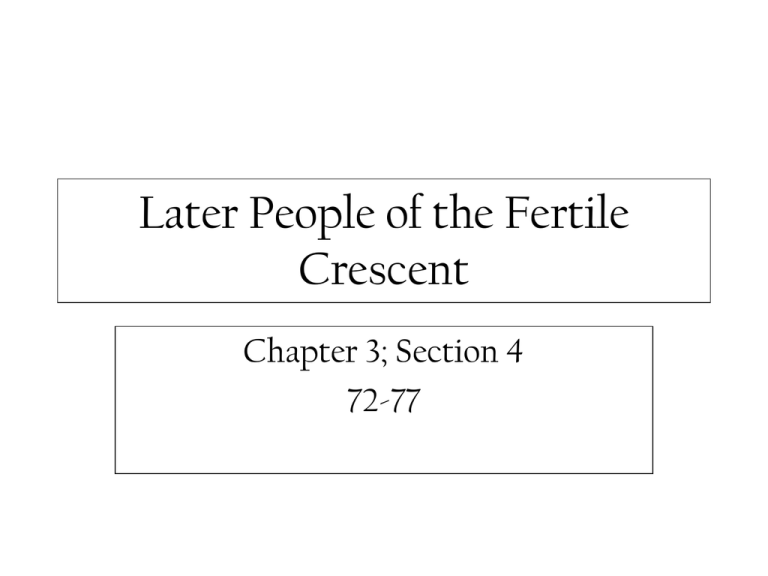
Later People of the Fertile Crescent Chapter 3; Section 4 72-77 Alphabet Book Examples Bell Work 9/18 and 9/19 • Read the excerpt on page 73. Then, answer the questions below in complete sentences. 1. 2. 3. 4. 5. Why is Hammurabi’s Code important to history? What do you think these laws indicate about the Babylonian system of justice? Why do you think the laws treat freed men differently from slaves? How do you think Hammurabi’s code of law affected citizens of that time? Thinking moralistic, what is another title or phrase you could give this law code? What civilization and then empire were located in the Fertile Crescent? Sumer was the civilization Akkadian was the name of the empire What firsts did each of them have? Sumerian Achievements • • • • • • • • • • • Civilization Epic Writing system Religion School Wheel Plow Architecture Science/Medicine Musical instruments Math Akkadian Achievements • • • • Empire Permanent Army Woman writer Defeated Sumer and Northern Mesopotamia Tips: Remember this Sentence Sam and Bob heard kangaroos and chimpanzees playing. Sam (Sumer) and (Akkad) Bob (Babylonian) heard (Hittites) kangaroos (Kassites) and (Assyrians) chimpanzees (Chaldeans) playing (Phoenicians) Later Empires of the Fertile Crescent 15-20 minutes Babylonian Hittites Kassites Assyrians Chaldeans or NeoBabylonians Phoenicians Question to Consider When filling out the Chart • Where were they from or where was their empire? • Who did they conquer? How? • Was there a ruler/leader mentioned? Interesting facts about the ruler/leader? • What were their achievements? OR Did they have any major resources? • How or why did the empire fall? Main Idea 1: The Babylonians conquered Mesopotamia and created a code of law. • Hammurabi was Babylon’s king. • During his rule, Babylon became the most important city in Mesopotamia. • Hammurabi’s Code was a set of 282 laws he created that dealt with almost every part of daily life. Hammurabi Babylon’s king and the city’s greatest monarch, or ruler of a kingdom or empire Brilliant war leader who brought all of Mesopotamia into his Babylonian Empire • Oversaw building and irrigation projects and improved the tax system • Developed a set of laws that was written down for all to see Hammurabi’s Code • Hammurabi wrote down 282 laws which contained some ideas still found in laws today. • Specific crimes brought specific penalties. • Social class was taken into account. It was a greater crime to injure a rich man than a poor one. • It was unique not only because of how thorough it was, but also because he wrote it down for all to see. Main Idea 2: Invasions of Mesopotamia changed the region’s culture. • Armies battled for control of fertile land. • Different peoples ruled Mesopotamia. – Hittites – Kassites – Assyrians – Chaldeans • Each group affected the culture of the region. The Hittites & Kassites The Hittites were the first to master ironworking, so they made the strongest weapons of the time. They used the chariot, a wheeled, horse-drawn cart, which allowed them to move quickly around the battlefield. They were taken over by the Kassites after their king was assassinated. The Kassites ruled for almost 400 years. The Assyrians • The Assyrians had a strong army that used chariots and iron weapons. • They spread terror before battles by looting villages and burning crops. • Assyrian kings ruled their empire through local leaders who each governed a small area. • The local leaders demanded heavy taxes. The Chaldeans or Neo-Babylonians • The Chaldeans attacked the Assyrians when they were weak and destroyed their empire. • Nebuchadnezzar rebuilt Babylon into a beautiful city that had the famous Hanging Gardens. • They admired the Sumerian culture, studied their language, and built temples to Sumerian gods. • Babylon became a center for astronomy. Main Idea 3: The Phoenicians built a trading society in the eastern Mediterranean region. Resources • Prized Cedar trees for timber • Accessed the sea for trade • Built great harbors Expansion of Trade Expansion of Trade • Sailed ships around the Mediterranean Sea • Founded several new colonies along the trade routes • Became wealthy Alphabet • Recorded their activities • Made writing much easier for everyone • Is the basis for the English language Later Empires of the Fertile Crescent Babylonian Hittites Kassites Assyrians Chaldeans Phoenicians •Conquered Sumer •Hammurabibrilliant leader, ruled for 42 years •Hammurabi’s Code- 1st written law code, 282 laws, and eye for an eye concept. •Stele of Hammurabi •Created Irrigation Projects and improves tax system •Hammurabi dies and empire declines (weakens) •Captured Babylon •Empire in presentday Turkey •Mastered IRONWO RKING and Used Chariots and fire arrows around the battlefield •Hittite rule did not last long •Lived north of Babylon •Kassite people captured the Hittite people after their king was assassinate d •Ruled for 400 years •In 900 BC, they started to conquer all of the Fertile Crescent •STRONG, ORGANIZED ARMY •They spread terror •Demanded heavy taxes and punished those who resisted •Built roads to link parts of the empire •Messengers on horseback to deliver messages (postal service) •Series of wars weakened the empire •Destroyed Nineveh and the Assyrian Empire and rebuilt Babylon •Nebuchadnezza r was their most famous ruler •Nebuchadnezza r build one of the wonders of the world “Hanging Gardens” •Admired Sumerian culture and studied their language •Babylon center of astronomy and geometry •Present-day land of Lebanon •Wealthy TRADING SOCIETY •Cedar and Purple Dye •Mountains blocked their trade routes, so they turned to the sea •Tyre-harbor •ColoniesCarthage •Had fast ships •Traveled around Mediterranean •World’s 1st alphabet 1. 2. 3. 4. 5. 6. 7. 8. 9. 10. 11. 12. Chapter End Rap http://www.flocabulary.com/fertile-crescentcivilizations/ Chapter 3 Summary Remediation Chapter 3-4 Assessment Questions 1. 2. 3. When did Hammurabi become Babylon’s king? How did Hammurabi conquer Mesopotamia? Why would it have been helpful for people to have the law code written down? 4. Why did the Hittite Kingdom come to an end? 5. What military advantages did the Assyrians have? 6. How do you think the use of chariots by Hittites affected the opposing army’s foot soldiers? 7. How did the Assyrians rule their empire? 8. What advances did the Chaldeans make? 9. Where did Phoenician ships sail? 10. Why was the Phoenician alphabet an important development? 11. What led the Phoenicians to create a successful sea trade?
